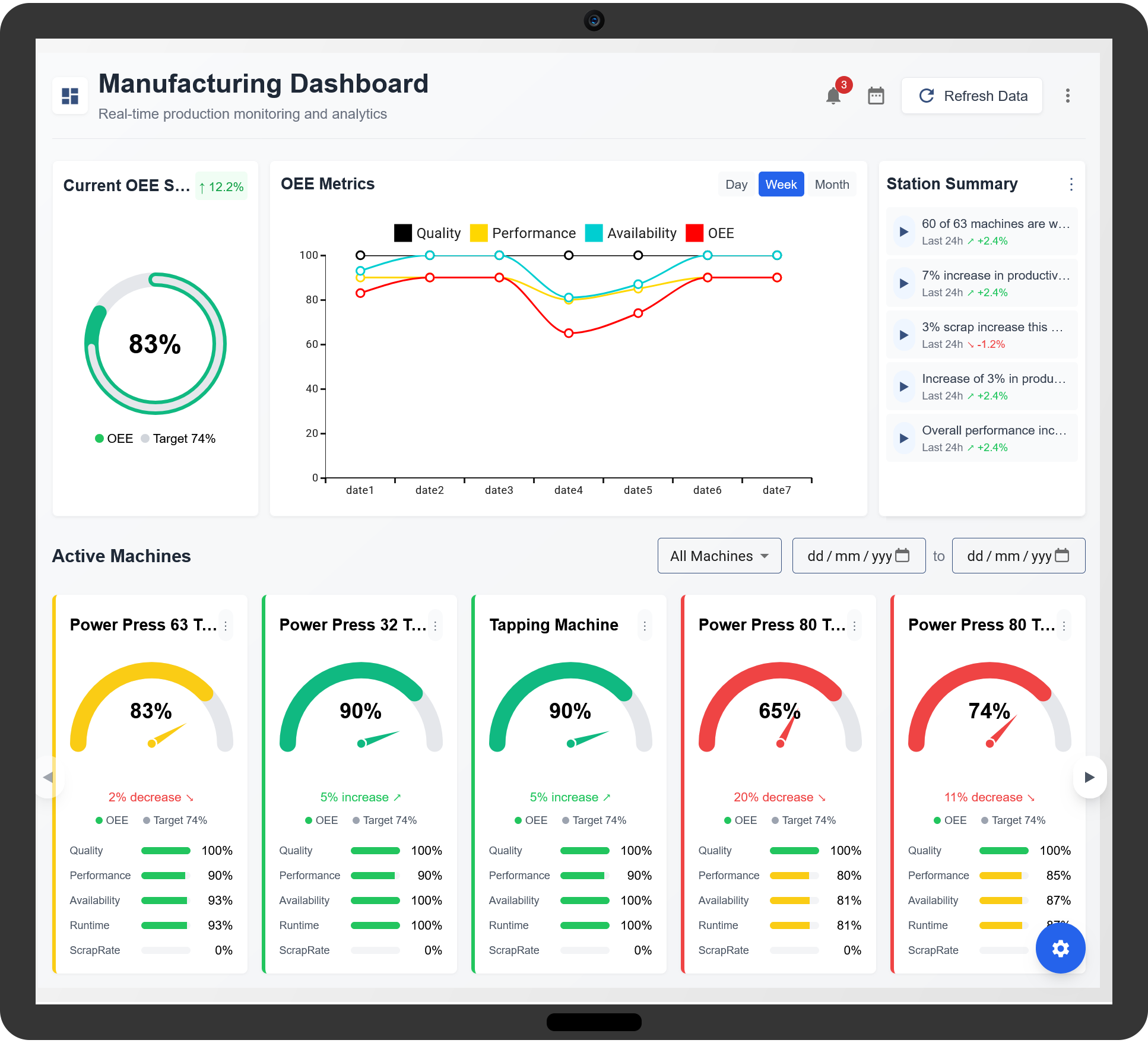OEE (Overall Equipment Effectiveness) software plays a crucial role in measuring manufacturing efficiency by collecting, analyzing, and interpreting data from production processes. By automating data collection, OEE software ensures accurate performance tracking and enables manufacturers to optimize their operations.

1. Key Aspects of OEE Data Collection
- Automated Data Acquisition: Captures data directly from machines and sensors to ensure real-time accuracy.
- Manual Data Entry: Allows operators to input specific performance metrics and downtime reasons.
- Integration with Existing Systems: Connects with MES, ERP, and SCADA systems for seamless data exchange.
- Real-Time Monitoring: Provides instant insights into equipment performance and production trends.
- Data Validation: Ensures the accuracy of collected data by eliminating inconsistencies and errors.
2. How OEE Software Collects Data
Step 1: Identifying Data Sources
The software integrates with various data sources such as PLCs, IoT sensors, and production databases to gather relevant information.
Step 2: Capturing Key Metrics
OEE software records essential performance indicators, including:
- Availability (Machine uptime vs. downtime)
- Performance (Actual speed vs. ideal speed)
- Quality (Defective units vs. total production)
Step 3: Data Processing and Storage
Collected data is processed and stored in a centralized database, making it easily accessible for reporting and analysis.
Step 4: Generating Reports and Dashboards
OEE software visualizes collected data through customizable reports and dashboards, helping manufacturers identify inefficiencies and improvement opportunities.
3. Benefits of Automated OEE Data Collection
- Enhanced Accuracy: Eliminates manual errors and ensures consistent data tracking.
- Real-Time Insights: Provides instant visibility into production performance.
- Improved Decision-Making: Empowers teams with actionable data to optimize manufacturing processes.
- Reduced Downtime: Identifies root causes of inefficiencies for quicker resolutions.
- Seamless Integration: Works with existing manufacturing systems for streamlined operations.
4. Future of OEE Data Collection
Advancements in AI and IoT are shaping the future of OEE software, enabling predictive analytics, automated maintenance scheduling, and machine learning-driven insights to further enhance manufacturing efficiency.
By leveraging OEE software for data collection, manufacturers can gain precise visibility into their operations, optimize productivity, and drive continuous improvement.
How does OEE software handle data collection?
What is OEE software?
OEE (Overall Equipment Effectiveness) software is a tool used to measure and improve manufacturing productivity by tracking availability, performance, and quality.
How does OEE software collect data?
OEE software collects data through direct machine connections, sensors, and manual inputs to track production performance and efficiency.
What types of data does OEE software track?
It tracks machine uptime, downtime, cycle times, defects, production output, and efficiency metrics.
Can OEE software collect data in real time?
Yes, OEE software captures real-time production data to provide instant insights into operational performance.
Does OEE software integrate with production machines?
Yes, it can connect to production machines via IoT sensors, PLCs, and other data collection devices.
How does OEE software track machine downtime?
It records machine stoppages, categorizes downtime reasons, and provides insights for reducing unplanned stops.
Can OEE software detect production bottlenecks?
Yes, it analyzes performance trends to identify constraints in the manufacturing process.
Does OEE software support manual data entry?
Yes, operators can manually input production data when automated tracking is not available.
How accurate is the data collected by OEE software?
OEE software ensures high accuracy by minimizing human errors and automating data capture.
Can OEE software generate reports based on collected data?
Yes, it generates detailed reports on equipment efficiency, downtime, and overall production performance.
Does OEE software support cloud-based data storage?
Yes, many OEE solutions offer cloud storage for easy access to production data from anywhere.
How does OEE software ensure data security?
It uses encryption, role-based access, and secure storage methods to protect sensitive production data.
Can multiple users access OEE data simultaneously?
Yes, OEE software allows multiple authorized users to view and analyze production data in real time.
How does OEE software help improve efficiency using collected data?
It highlights inefficiencies, tracks trends, and provides actionable insights for process improvement.
Is OEE software suitable for all types of manufacturing?
Yes, OEE software is adaptable for various manufacturing industries, including automotive, food, and electronics.